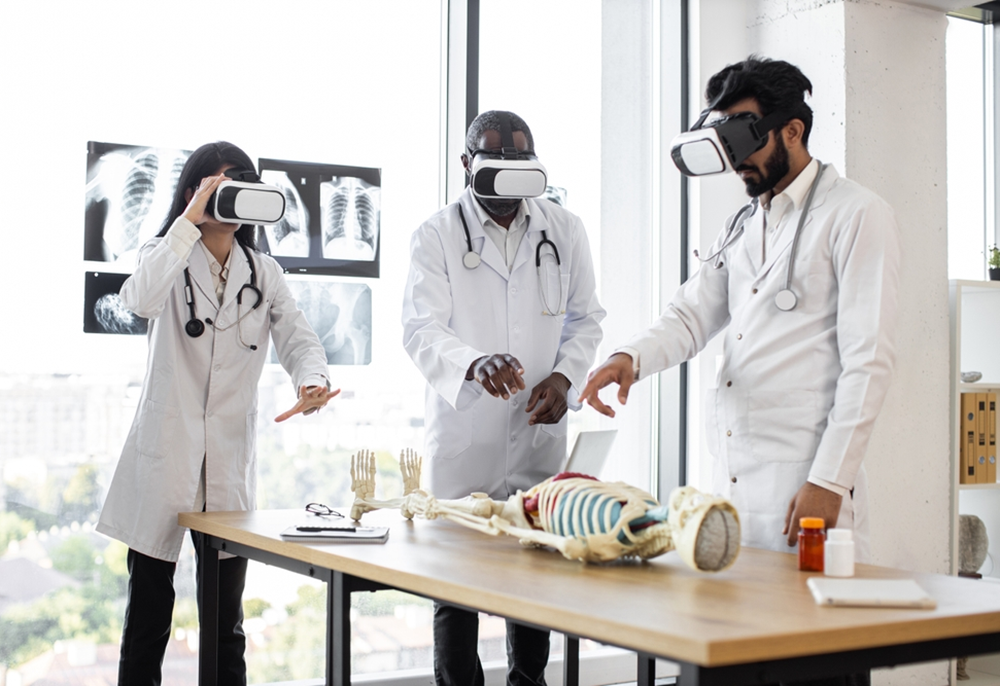Medical education has traditionally been primarily textbooks, lectures, and standardized patients. These methods have been useful, but they tend to lack the hands-on experience and engagement that is needed to create rounded medical professionals. Virtual reality (VR) comes into play here, providing a transformative way of medical education.
VR for medical experience (VR MedEd) is the creation of immersive simulations. This enables medical students and professionals to practice procedures, see complex anatomy, and develop important skills in a safe and controlled environment.
This innovative technology is transforming the way medical training is done and has a host of benefits for learners and educators alike.
Why VR in Medical Education
Let us quickly go through the benefits of VR when it comes to imparting medical education-
- Enhanced Learning: The VR is found to improve such knowledge retention and comprehension more than the traditional methods of learning.VR’s immersive nature enables learners to become immersed and have a more active role in their learning of material, leading to enhanced understanding and critical thinking.
- Safe Practice Environment: Students can practice complex procedures in a VR simulation first, before being introduced to real patients. It diminishes the threat of blunders and lets us rehearse routinely, thus promoting more and more self-assurance and adequateness.
- Accessibility and Scalability: Geographical limitations and resource constraints can be overcome by the use of VR simulations. Access to a huge library of realistic scenarios democratizes high-quality medical education.
- Standardized Training: The VR simulations provide students with a consistent, standardized, and instructor-independent learning experience across all students and instructors. It fills this gap between theoretical knowledge and skills.
- Improved Psychomotor Skills: Based on the psychomotor skills one would like to practice with virtual simulations, one can map that out to the target psychomotor requirements. Or, more precisely, among the training in surgery and other highly technical procedures, this is especially invaluable.
Transformative Role of Virtual Reality in Medical Education
Although there is an initial investment in VR technology, this can help to cut training costs as expensive standardized patients and cadavers will no longer be required. Moreover, VR for higher education, including medical training, provides an engaging, hands-on learning experience that traditional methods often lack. While these methods have served their purpose, they often lack the engagement and practical immersion crucial for developing well-rounded medical professionals. This is where virtual reality (VR) steps in, offering a transformative approach to medical education.
VR for medical experience, also known as VR MedEd, creates immersive simulations that allow medical students and professionals to practice procedures, explore complex anatomy, and build crucial skills in a safe and controlled environment.
This innovative technology is rapidly reshaping the landscape of medical training, offering a multitude of benefits for both learners and educators.
Reduced Costs: While there is an initial investment in VR technology, it can ultimately reduce training costs by eliminating the need for expensive standardized patients and cadavers.
VR in Action: Exploring the Potential
VR MedEd applications span from anatomy and physiology, through surgery, to patient communication. Here are some specific examples:
Anatomy Learning: Think about taking apart a virtual human body in 3D, looking at the smallest of details from any angle, and moving around organs in real-time. This level of interactive learning is made possible by VR and makes anatomy come alive for students.
Surgical Training: The complexity of the surgery can be simulated by VR in a safe environment, with VR simulations able to replicate complex surgical procedures with realistic haptics allowing trainees to practice delicate maneuvers and decision-making. Improved surgical skills and reduced complications for patients can result from this.
Patient Communication Skills: With VR, medical professionals can practice empathy, interactions with difficult patients, communication techniques, and cultural sensitivity without putting patients in harm’s way. It results in better doctor-patient relationships and better patient care.
VR for Surgery Training: Advancing Medical Expertise
Surgery training is one of the most exciting applications of VR MedEd. VR for surgery training allows surgeons to:
- Perform complex procedures safely in a risk-free environment
- Learn to make critical decisions under pressure
- It refines hand-eye coordination and spatial awareness.
- Get exposure to rare surgical scenarios
Such companies include iXRLabs at the cutting edge of VR training platforms for surgeons. It lets surgeons keep practicing their skills to stay current on the latest in their field.
The Road Ahead for VR MedEd
Despite the great potential of VR MedEd, there are still some things to work through. The initial investment cost of VR technology include the requirement of robust content development. And the accessibility of VR experiences to all learners are all part of these.
As VR technology matures and the price comes down, we will see more and more of it in medical education.
It holds the promise to change it all and improve health outcomes for patients overall through better-trained healthcare professionals.






